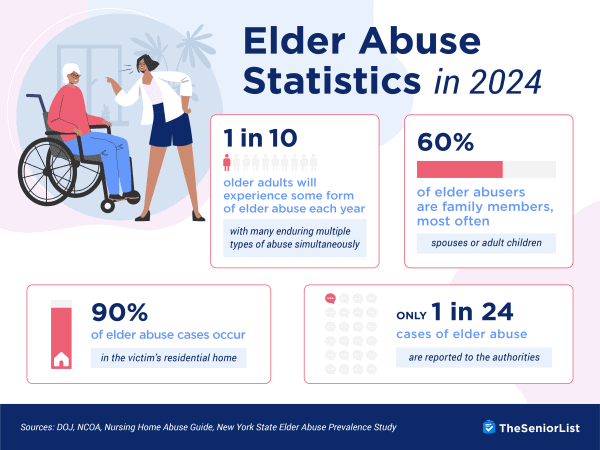Elder Abuse Statistics in 2024

What Is Elder Abuse?
Elder abuse affects as many as one in six older adults every year, and in a majority of cases, it’s perpetrated not by strangers but by family members, friends, and caregivers.
Recognizing the warning signs of elder abuse, as well as its prevalence and the variety of forms it takes, is an essential way to protect our loved ones. This rundown of elder abuse statistics will cover each of these areas.
Types of Elder Abuse
“Elder abuse” is often used in reference to physical violence, but it is an umbrella term for multiple types of behavior that harm older adults.
- Physical abuse refers to any pain or injury inflicted upon a senior, including hitting, shoving, and forceful restraining.
- Sexual abuse encompasses any unwanted sexual contact, touching, or fondling, whether through physical force or disregard for a person’s consent.
- Emotional abuse takes many forms, including threats, belittlement, name-calling, or accusations. Cutting off seniors from contact with their loved ones or their belongings is another form of emotional abuse.
- Financial abuse includes scamming mentally incapacitated seniors, withholding their funds for personal gain, or otherwise misusing their resources.
- Neglect occurs when caregivers fail or refuse to properly care for the senior in their charge and the person can become hurt or ill.
FYI: Neglect can even occur accidentally. To prevent it from happening to your loved ones, read our guide: How to Become a Caregiver.
Statistics on Elder Abuse
To better understand the prevalent yet often silent issue of elder abuse, consider the statistics below.
Elder Abuse Prevalence
- Each year, one in 10 older adults will experience some form of elder abuse, and many endure multiple types of abuse simultaneously.
- Over 5 percent of seniors become the victim of financial fraud or exploitation yearly.
- In the past 20 years, the rate of nonfatal assaults involving seniors has risen over 75 percent for men and over 35 percent for women.
- Nearly 5 percent of all seniors are subjected to psychological abuse in any given year.
- The World Health Organization estimates that 320 million seniors will suffer from elder abuse by 2050.
- Emotional neglect from family members is the most common form of elder abuse (nearly 27 percent).
Elder Abuse Demographics
- 60 percent of elder abusers are family members — most often spouses or adult children.
- 64 percent of long-term care staff report committing abuse to some degree in the past year.
- Nearly 42 percent of seniors with dementia experience emotional abuse from their caregivers.
- Over 65 percent of the victims of elder abuse are women.
- Seniors with disabilities are nearly twice as likely to experience elder abuse.
- Nonwhite seniors are 200 percent more likely to be victims of elder abuse compared to white seniors.
Where Elder Abuse Occurs
- 90 percent of elder abuse cases occur in the victim’s residential home.
- Over 91 percent of seniors who have suffered abuse at the hands of family members report being satisfied with those family members, despite being abused.
- At least 95 percent of nursing homes are understaffed, leading to a high prevalence of neglect.
Elder Abuse Reporting
- Only one in 24 cases of elder abuse is reported to the authorities.
- One in 12 cases of psychological elder abuse goes unreported.
- Nearly 10,000 complaints of nursing home abuse are filed every year.
- Around 16,000 reports of sexual abuse have been filed from nursing homes alone since 2000.
Elder Abuse Effects
- Seniors who suffer financial abuse collectively lose over $2.6 billion every year.
- Financial abuse victims are 300 percent more likely to die prematurely than those who suffered no abuse.
- Despite the prevalence of financial abuse, the wealthiest seniors are 70 percent less likely to suffer elder abuse.
Signs of Elder Abuse
The signs of elder abuse differ depending on the type of abuse that has been inflicted. For physical abuse, signs may include scrapes, bruises, broken limbs, burns, and other injuries. The signs of emotional abuse or neglect are often harder to spot, especially if they overlap with any of your loved one’s health conditions.
Dehydration, mood changes, poor hygiene, weight loss, confusion, and signs of malnourishment could all indicate abuse or neglect. The best way to address these signs is to observe your loved one’s behavior for changes. Ask their doctor if they have noticed anything that isn’t in line with the expected symptoms of their age or condition.
Especially in cases of abused seniors with impaired cognition, loved ones often have to step up, recognize, and stop abuse since their loved ones can’t recognize it or act on their own.
Preventing Elder Abuse
Preventing elder abuse can be difficult, since it can come from numerous sources. If you suspect a family member is to blame, talk to other family members to see if you can deal with the problem without putting your senior loved one through an official investigation.
In the case of abuse at the institutional level — such as neglect by a care home staff member — you need to be diligent about spotting the signs in your loved one and taking action accordingly. It may entail contacting adult protective services or the police.
Neglect of a senior loved one can also stem from a caregiver being burdened by or burned out from the responsibilities of care. They may not be willfully neglecting them. Look for the signs of burnout in the caregiver, and offer to help reduce their burden either by volunteering your time or paying for adult daycare services.
The most important step in preventing elder abuse is to listen to your senior loved one, as well as their caregivers, doctors, and other family members. Your loved ones often will express their concerns to people willing to listen. Sometimes recognizing the signs of abuse means hearing them when no one else will.

